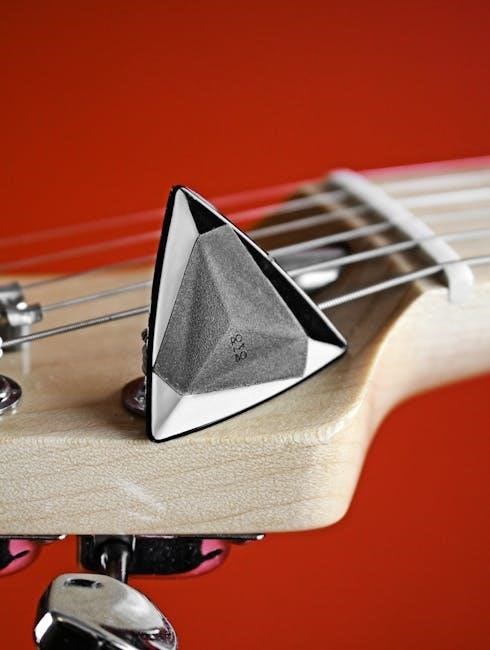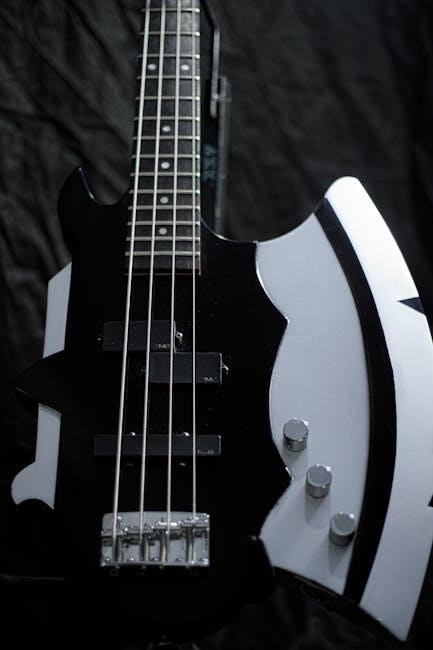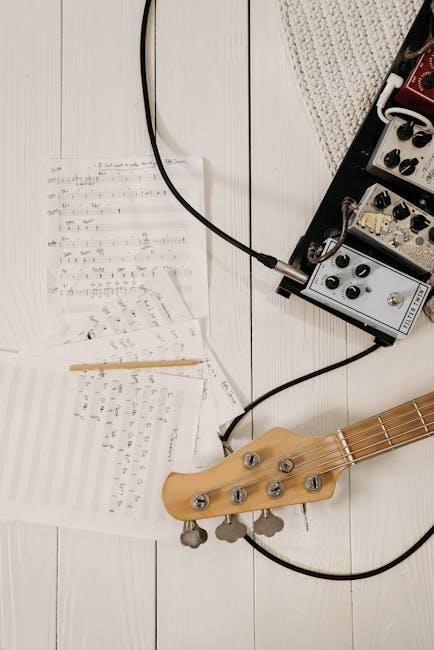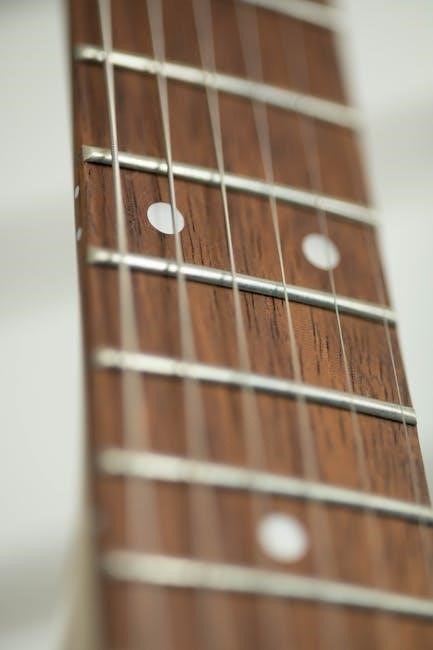
A fretboard notes PDF is a comprehensive guide for guitarists, providing a visual layout of all notes across the fretboard. It helps master guitar playing by understanding note positions, intervals, and scales, enhancing musical knowledge and technique through clear, structured content.
What is a Fretboard Notes PDF?
A fretboard notes PDF is a visual guide detailing the layout of guitar notes across the fretboard. It maps out every note on each string and fret, serving as a valuable tool for musicians to learn and reference note positions. These PDFs often include diagrams, note charts, and sometimes interval shapes, making them essential for understanding music theory in a practical way. They are particularly useful for beginners learning the basics and for advanced players refining their skills. Many resources offer free or paid downloadable versions, catering to different learning styles and levels. By using a fretboard notes PDF, guitarists can enhance their familiarity with the instrument and improve their ability to play scales, chords, and melodies with precision and confidence.
Importance of Learning Fretboard Notes
Mastering fretboard notes is essential for any guitarist aiming to enhance their musical understanding and playing abilities. Knowing the notes on the fretboard improves improvisation, composition, and overall musicianship. It allows for better navigation of the guitar neck, enabling players to find notes quickly and accurately. Understanding note positions also enhances chord and scale playing, as it reveals the relationships between notes. This knowledge is crucial for learning music theory in a practical context and for developing a deeper connection with the instrument. By familiarizing oneself with the fretboard, guitarists can expand their creative possibilities and perform with greater confidence and precision. Whether for casual playing or professional performance, learning fretboard notes is a foundational skill that greatly enriches the guitar-playing experience.

Understanding the Guitar Fretboard
The guitar fretboard consists of strings, frets, and dots or inlays to identify note positions. Learning its layout helps navigate notes, intervals, and scales, enhancing playing and theory skills.

Basic Layout of the Guitar Fretboard
The guitar fretboard is organized into strings and frets, with each string representing a specific note when played open. The layout includes markers called frets, which divide the neck into segments, each raising the pitch by a half-step. Open strings (E, A, D, G, B, e) form the foundation, and pressing the string behind a fret changes the note. Dots or inlays on the fretboard help identify positions, typically placed at intervals like the 3rd, 5th, 7th, and 12th frets. This design allows guitarists to navigate notes, intervals, and scales systematically, making it easier to learn and play music effectively.
Open Strings and Their Corresponding Notes
The guitar’s open strings correspond to specific notes in standard tuning: E (low), A, D, G, B, and e (high). These notes serve as the foundation for understanding the fretboard layout. Learning their pitches is essential for identifying notes on the frets. For example, the low E string is the thickest string, while the high e string is the thinnest. Each open string note repeats at the 12th fret, creating an octave. Memorizing these notes helps guitarists navigate the fretboard effectively and build a strong musical foundation. Mnemonics, like “Eddie Ate Dynamite Good Bye Eddie,” can aid in remembering the order of open strings from low to high. This knowledge is critical for playing chords, scales, and melodies accurately.

How to Memorize Fretboard Notes
Divide the fretboard into sections and focus on learning notes progressively. Start with open strings and their corresponding notes, using mnemonics for better retention. Consistent practice and visualization techniques enhance mastery.
Step-by-Step Guide to Learning Notes on Each String
Begin with the low E string, identifying open notes and memorizing their positions. Move to the A string, noting its similarity to the low E but two frets higher. Next, focus on the D string, recognizing its pattern. The G string follows, with a unique layout that breaks the sequence slightly. Learn the B string, adjusting for its one-fret shift compared to the E string. Finally, master the high E string, mirroring the low E; Use flashcards or diagrams to reinforce each string’s notes, practicing scales and chords to apply your knowledge practically. Consistency and repetition are key to long-term retention.
Using Mnemonics to Remember Notes
Mnemonics are powerful tools for memorizing fretboard notes. Create catchy phrases or sentences where each word corresponds to a note. For example, “Eddy Ate Dynamite Good Bye Eddy” helps remember the open strings (E, A, D, G, B, E). This absurdity makes it memorable. Assign unique phrases to each string, focusing on note sequences. For lower strings, use phrases like “Eddie” for the low E string (E, F, G, A, B, C, D, E). For higher strings, create similar associations. Personalize mnemonics to make them relatable, enhancing retention. Practice regularly to reinforce these memory aids, making note recognition second nature. Over time, this method simplifies mastering the fretboard layout.

Best Fretboard Notes PDF Resources
Top-rated fretboard notes PDFs offer detailed layouts and learning strategies. Resources like Ricky’s Guitar and Guitar Pro provide structured guides. Free options are available online, while paid versions offer advanced features for deeper understanding.
Top-Rated PDF Guides for Fretboard Notes
Top-rated PDF guides for fretboard notes offer comprehensive layouts and learning strategies. Ricky’s Guitar and Guitar Pro provide structured, detailed resources. These guides often include interactive tools, such as note finders and interval maps, to enhance learning. Many top-rated PDFs are designed for both beginners and advanced players, covering essential topics like open strings, scales, and chord shapes. Some guides also incorporate mnemonics and practice exercises to aid memorization. Additionally, resources like Song Notes and fretboard diagram generators are highly recommended for visual learners. These PDFs are available both free and paid, with paid versions offering more advanced features and in-depth lessons.

Free vs. Paid Fretboard Notes PDFs
When choosing between free and paid fretboard notes PDFs, consider your learning needs. Free PDFs are ideal for beginners, offering basic fretboard diagrams and note charts. They often include open string notes and simple scales, providing a solid foundation. However, free resources may lack detailed explanations or advanced techniques. Paid PDFs, on the other hand, offer comprehensive guides with in-depth lessons, interactive exercises, and professional layouts. They cater to both intermediate and advanced players, covering topics like intervals, chord shapes, and complex scales. Some paid guides also include video lessons or software integration. While free PDFs are a great starting point, paid resources provide more structured and advanced learning experiences. Choose based on your skill level and the depth of knowledge you seek.
Official statement: This response is generated based on the provided internet data and is for informational purposes only.

Advanced Techniques for Mastering Fretboard Notes
Mastering fretboard notes involves understanding intervals, scales, and chord shapes. Advanced techniques include visualizing note patterns, using mnemonics, and applying music theory to enhance fretboard navigation and improvisation skills.
Understanding Intervals on the Fretboard
Intervals are the building blocks of music, representing the distance between two notes. On the fretboard, understanding intervals helps guitarists navigate scales, chords, and arpeggios more effectively. By recognizing intervals such as major and minor thirds, fourths, fifths, and octaves, players can construct chords and scales with precision. For example, a major scale consists of specific interval patterns: whole, whole, half, whole, whole, whole, half steps. Visualizing these intervals on the fretboard enables guitarists to play melodies and harmonies with confidence. Additionally, intervals are crucial for improvisation, allowing musicians to create solos and riffs that align with the key of the song. Mastering intervals enhances overall fretboard fluency and musical expression.
How to Apply Scales to the Fretboard
Applying scales to the fretboard is essential for developing musicality and technique. Start by identifying the root note of the scale and its position on the fretboard. For example, in the C major scale, the root note is C, located on the 3rd fret of the A string. From there, follow the interval pattern of the scale: whole, whole, half, whole, whole, whole, half steps. Visualize the scale shape across the fretboard, ensuring each note aligns with the correct interval. Practice playing the scale in different positions and octaves to build familiarity. Using a fretboard notes PDF can provide clear diagrams and patterns, helping you apply scales effectively. Regular practice reinforces muscle memory, enabling seamless execution of scales in various musical contexts.

Tools and Apps for Learning Fretboard Notes
Utilize interactive tools and apps like Guitar Pro and Fender Play to visualize and learn fretboard notes effectively. These resources offer step-by-step lessons and exercises, enhancing your learning experience.
Interactive Tools for Visualizing Fretboard Notes
Interactive tools like Guitar Pro and Fender Play offer dynamic visualizations of the fretboard, helping users identify notes and intervals. These tools allow real-time exploration, making learning engaging and effective. Additionally, apps such as GuitarTuna provide tuners and exercises to reinforce note recognition. For those seeking structured courses, platforms like TrueFire and JamPlay offer comprehensive lessons with progress tracking. These resources cater to all skill levels, ensuring that whether you’re a beginner or an advanced player, you can find a tool that fits your learning style. By leveraging these interactive tools, guitarists can build a strong foundation in fretboard notes, enhancing their overall musicianship and creativity.
Apps That Help You Master Fretboard Notes
Apps like Fender Play and Yousician are excellent for mastering fretboard notes, offering interactive lessons and exercises tailored to skill levels. Guitar Tricks features video lessons and progress tracking, while Fretboard Hero provides gamified challenges to make learning fun. Apps such as Notes on the Fretboard offer quizzes to test knowledge, reinforcing note recognition. Additionally, tools like Perfect Ear help with interval training, essential for advanced techniques. These apps integrate seamlessly with practice routines, ensuring consistent improvement. By utilizing these resources, guitarists can efficiently learn and master fretboard notes, unlocking new levels of musical expression and confidence in their playing abilities. Regular use of these apps can significantly accelerate the learning process and improve overall guitar proficiency. These apps are indispensable for modern guitarists aiming to enhance their skills and understanding of the fretboard.

Common Mistakes to Avoid
Common mistakes include rushing the learning process, neglecting open string notes, and poor practice habits. Avoid relying solely on diagrams without understanding note relationships and intervals. Consistency is key.
Misconceptions About Learning Fretboard Notes
One common misconception is that learning fretboard notes is overly complicated or impossible. Many believe it requires innate talent or years of dedication. However, this is not true. With a systematic approach, anyone can master the fretboard. Another myth is that memorizing notes is unnecessary for playing songs or improvising. In reality, knowing your notes enhances creativity and precision. Some think focusing on scales alone is enough, but understanding individual notes provides a deeper foundation. Avoid the mistake of rushing through lessons or skipping basics. Break the fretboard into manageable sections, and practice consistently. Misconceptions often stem from frustration, but patience and the right techniques make learning accessible and rewarding.
Tips for Effective Practice
Effective practice begins with consistency and clear goals. Start by dividing the fretboard into smaller sections, such as frets 0-4, 5-8, and 9-12, to make learning manageable. Focus on one string or area at a time, ensuring mastery before moving on. Use mnemonics, like “Eddy Ate Dynamite Good Bye Eddy,” to remember open strings. Practice identifying notes without looking at the fretboard to improve familiarity. Set aside time daily, even if brief, to reinforce memory. Incorporate flashcards or apps to test your knowledge. Apply notes to real music by playing scales or melodies, making practice engaging. Record your progress to track improvement. Stay patient and celebrate small victories to maintain motivation. Consistent, focused practice is key to mastering fretboard notes efficiently.

Mastery of fretboard notes transforms your guitar playing; With dedication, the right tools, and consistent practice, you’ll unlock new musical possibilities. Embrace the journey and enjoy your progress!
Final Thoughts on Mastering Fretboard Notes
Mastery of fretboard notes is a transformative journey for any guitarist. It enhances your ability to play, improvise, and compose music effectively. By understanding the layout and relationships between notes, you unlock endless creative possibilities. Consistent practice, paired with the right resources like fretboard notes PDFs, simplifies the learning process. Remember, progress takes time, so stay patient and persistent. Celebrate small victories, and most importantly, enjoy the music you create along the way. With dedication, you’ll not only master the fretboard but also deepen your connection to the instrument and the music it produces.
Resources for Further Learning
Expanding your knowledge beyond the fretboard notes PDF requires exploring additional resources. Websites like GuitarTuna offer interactive tools for note identification, while Guitar Pro provides advanced lessons and virtual backing tracks. YouTube channels and structured courses can guide you through complex techniques. Apps like Fender Play and Yousician gamify learning, making it engaging. Books and eBooks, such as those by Ricky’s Guitar, provide in-depth theory and practical exercises. Online forums and communities, like Reddit’s r/guitar, connect you with fellow musicians for tips and support. Utilize these resources to deepen your understanding and continue your musical growth.
Encouragement to Keep Practicing
Remember, mastering the fretboard is a journey, not a destination. Consistent practice, even for a few minutes daily, will build confidence and skill over time. Celebrate small victories, like memorizing a new string or understanding an interval. Don’t be discouraged by challenges—frustration is temporary, but progress is permanent. Stay motivated by setting achievable goals and rewarding yourself for milestones reached. Most importantly, enjoy the process of learning and the joy of creating music. Every note you learn brings you closer to unlocking the full potential of the guitar. Keep pushing forward, and you’ll soon see the results of your dedication.